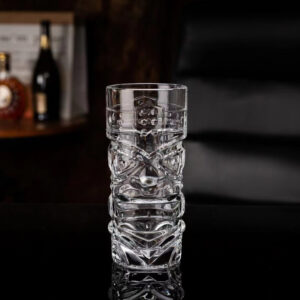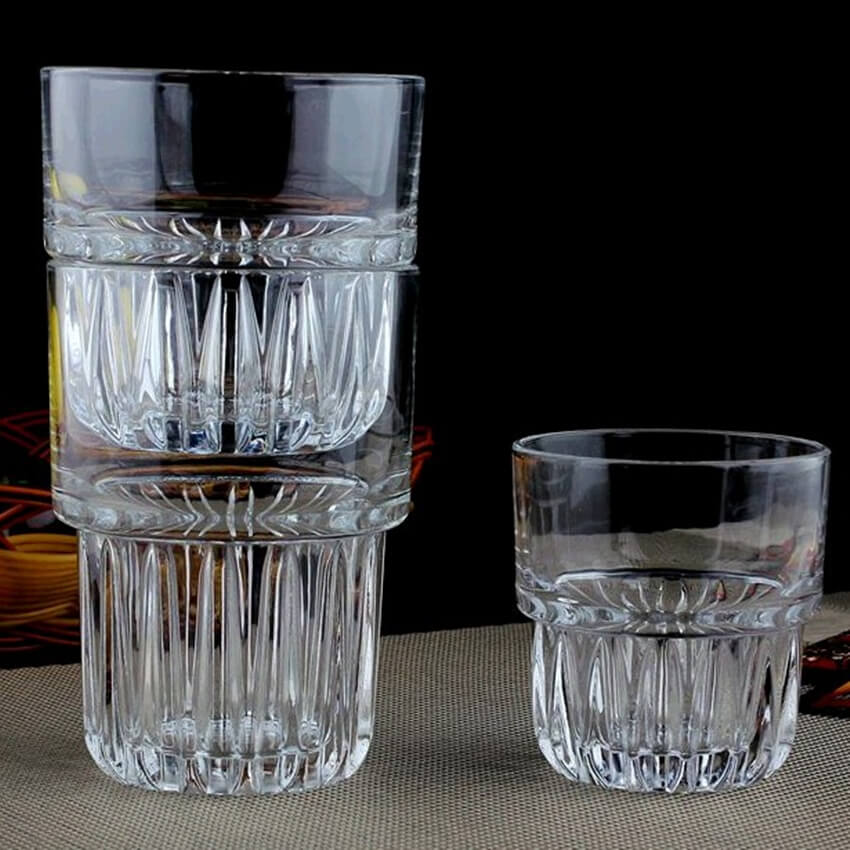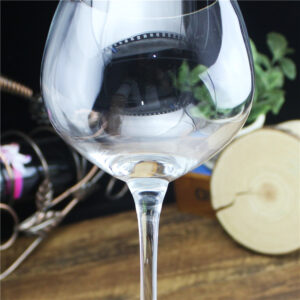Understanding the Difference: Hand-Blown vs. Machine-Made Glassware
When venturing into the world of glassware, it’s essential to recognize the intricate differences between hand-blown and machine-made glasses. These distinctions not only reflect in their appearance and texture but also in their value, usability, and price. Before we delve into these differences, it’s important to first understand the two dominant types of machine production methods for glassware: machine-pressed and machine-blown.
- Machine-Pressed Glass (MPG)
- Machine-Blown Glass (MBG)
- Hand-Blown Glass (HBG)
Part 1: Differentiating Between Machine-Pressed Glass (MPG) and Machine-Blown Glass (MBG)
-
Shape Machine-pressed glasses typically have a distinct form. They usually exhibit a larger top diameter compared to the bottom, often resembling the shape of a V. This can, however, limit the variety of shapes that these types of glasses can achieve.
In contrast, machine-blown glasses offer a greater diversity of shapes. From glasses with a smaller top diameter to ones with a more bulbous, belly shape, machine-blown glasses cater to a wider range of design preferences. In essence, they have more shapes to offer compared to machine-pressed glasses.
-
Thickness and Transparency In terms of thickness, machine-pressed glasses generally measure around 3–5mm, resulting in a robust and sturdy feel. Machine-blown glasses, on the other hand, are slimmer, with a thickness of around 1–2mm. This thinness makes machine-blown glasses more transparent, providing a clearer view of the beverage within. Additionally, the sound produced when clinking machine-blown glasses is clear and sharp, while machine-pressed glasses produce a duller sound, due to their thickness.
-
Top Rim, Bottom Marks, and Glass Finish Machine-pressed glasses (MPG) have a top rim that’s smooth and regular, devoid of any blemishes. The bottom of these glasses bears marks from the machine cutting the material. The overall surface of the glass is even and regular, reflecting the consistency of machine production.
In contrast, machine-blown glasses (MBG) feature a top rim characterized by a circle and a dot. The bottom also has marks, and the glass surface typically carries round mold marks, a testament to their production process.
-
Weight If you compare two glasses of the same size, one machine-pressed and the other machine-blown, the machine-pressed glass would weigh more. This is a result of the thicker glass used in its production.

Machine Pressed Glass Machine Blown Glass
Part 2: Distinguishing Between Machine-Blown Glass (MBG) and Hand-Blown Glass (HBG)
Generally speaking, the art of hand-blowing glassware allows artisans to create any shape that can be achieved by machine-blown methods and even more. Hand-blown glassware is a more customized and high-end type of glassware, typically used for elegant pieces like martini glasses, goblets, and stem glasses.
Apart from traditional stemmed hand-blown glasses, there are also stemless variants. These can be created using machine-blown methods, which is an excellent option when large quantities are needed, and budget constraints need to be considered.
A key difference between machine-blown and hand-blown glasses is the top rim. Hand-blown glasses do not feature a spot on the rim. After the glass is cold-cut, the rim is polished using a fire gun, giving it a smooth finish.
So, when you’re assessing a piece of glassware, consider these factors:
- Cost: Handmade glass typically costs 5–6 times more than machine-made glass. This is due to the labor-intensive process and the skills required to create each piece.
- Transparency and Finish: Handmade glass generally has superior transparency and finish. The extra time and care taken in crafting each piece are evident in its quality.
- Top Rim: Machine-blown glasses typically have a spot on the rim, a tell-tale sign of their production process.
- Stem: Machine-blown methods are incapable of creating stemmed glasses, a feature often associated with high-end and elegant glassware.
Conclusion: An Insight into the Art of Glassware
Our exploration into the world of glassware, comparing machine-made and hand-blown products, illuminates the fascinating intricacies behind these seemingly simple objects. The clear distinction between machine-pressed, machine-blown, and hand-blown glassware underscores the complexity and craftsmanship inherent in the industry.
From the shaping, thickness, transparency, and weight differences in machine-pressed and machine-blown glasses, it is evident that machine production offers a wide spectrum of choices for consumers, balancing cost-effectiveness with design diversity.
Yet, when we consider hand-blown glasses, the value proposition shifts from mass-production efficiency to individual artistry and craftsmanship. Despite their higher price point, hand-blown glasses command attention due to their unique forms, high-quality finishes, and the unparalleled skill required for their creation.
In evaluating these three types of glassware, we’re reminded that each serves different needs and preferences. Machine-pressed glasses, with their robust structure, serve as functional, everyday items. Machine-blown glasses, with their varied shapes and transparency, provide an appealing balance between cost and aesthetics, suitable for a range of uses.
Hand-blown glasses, however, rise above the ordinary. With their exquisite craftsmanship and high-end appeal, they are more than just functional objects—they are works of art. For those who appreciate the finer things in life, the beauty, uniqueness, and tactile pleasure of hand-blown glasses are unrivaled.
It’s evident that the world of glassware is rich and diverse, catering to a broad spectrum of needs and desires. Whether you’re a budget-conscious buyer or a discerning collector, understanding these differences can guide you to make the best choice that suits your preferences and meets your requirements.
Our journey does not end here. As we continue to navigate the captivating world of glassware, we invite you to join us in further explorations and discussions. After all, in the realm of glassware, there’s always more to discover, appreciate, and discuss. We look forward to continuing this fascinating conversation with you.
We always appreciate feedback, insights, or any additional information you may have. We invite you to engage with us and share your thoughts on this comprehensive guide. Let’s enrich this conversation about glassware together! Contact Lida!








